December 10, 2020
Eating Food in 2020

It all started with food, the panic. March 11, 2020. We were supposed to fly to England the following Monday, but after two days of agonizing, we’d decided to cancel our trip, speaking of unprecedented. We’d been saving up for two years and there was $5000.00 down the tubes (no small potatoes), but I knew something was very wrong, and I didn’t want to chance it. Stories of ICU doctors in Italy, how what was happening there was nothing like what they’d ever seen before. Italy was not so very far from England, was what we were thinking, before it became clear that nowhere is actually far from anywhere.
And so I went shopping. I picked up my children from school and we went to the grocery store, the last time my children were at the grocery store. “This is the panic shop,” I told them, and they were delighted, because I told them they could have anything they wanted. Our cart was laden with chips and ice cream, but also frozen vegetables, and cans of soup and beans. It was too much for me to carry home, because I hadn’t brought my shopping buggy, but I carried it anyway (there’d be no such thing as hoarding if we all had to carry it home on our backs), all the way up the road to the Bulk Barn where we bought a huge bag of mini-eggs.
“I don’t know if any of this is actually necessary,” I noted, “but at least we’ll have mini-eggs.”
A month later, it was with a sense of disbelief that we finally cracked that bag of mini-eggs open, that whatever was going on had lasted all the way until Easter—and that the mini-eggs had lasted too, but I am by nature a stockpiler of splendid things. It’s how I roll. I would rather anticipate something than eat it any day.
These days I get emails from all the grocery stores, because in mid-March I passed along my details to all of them in an effort to have groceries delivered, and it was always after I’d signed up that I was informed that the next available delivery window was never. But then somebody I followed on Instagram alerted me to a office snack supply company who’d quickly pivoted to groceries, and my first delivery arrived the next day, which included a box of 40 bags of Miss Vickie’s chips a palimpsest of the pre-pivot times.
But the chips were important. Necessary for hunkering down, and also we needed to have cake every day at 3pm, and ice cream after dinner. Treats were mandatory, and delicious, giving shape and ceremony to our otherwise humdrum days. Croissants from the Harbord Bakery, once I finally started venturing out to small shops, where I could also buy fancy cheeses and crackers, and Kawartha Dairy Ice Cream in little tiny cartons, which my children had only ever seen on television before, and called “emotional support ice cream.”
I also really got into making sourdough bread, because my friend Marissa, very presciently, had given me a starter in January, and I baked the bread regularly until it got too hot to turn the oven on. Since summer ended, I have not resumed baking the bread however, because I don’t have the time like I did before, or maybe I just can’t be bothered, but my starter is still going strong, and we use it for sourdough waffles, and the bread I order from my Mama Earth Organics is more of a sure thing anyway. (Mine frequently turned out weird.)
We have been customers of Mama Earth Organics for ten years now, and have never valued them more than when grocery stores seemed inaccessible to us in the spring and yet we had fresh fruit, vegetables, eggs and yogurt delivered weekly. They increased their product list and we began to expand our orders with them, and appreciated the chance to purchase food from so many local producers. We also started buying chocolate and coffee and vegan cheeses to make better choices for the planet, inspired by everyone’s very enviro newsletter.
And speaking of local producers, and how food delivery broke up our days, I started ordering from Spade and Spoon to receive pickles, jams, maple syrup and more, and we ordered our Easter chocolate from a local producer, and there was even a woman who delivered us popsicles, and we’d order donuts too, and it was also so delicious and lovely and fun when little else was.
But not everything was fancy, A quick trip to the convenience store on the corner for mozzarella and milk, bananas, and they had flour. FLOUR. In April 2020, this was no small thing. (I’d previously purchased 44lbs of flour from an actual MILL [artisanal, of course], but then when I was alerted to just how much flour that was, with no preservatives at that, I had to cancel. It’s been a very strange year.)
And remember in April when we made a lasagne that was featured in the New York Times?
And then there was takeout, which was performed as a public service, and we were nervous about it the first time we did it, ordering sushi because it seemed like if anyone would be conscious of food safety and hygiene, sushi was it—but after that we didn’t worry so much anymore. Though I would also routinely have mini nervous breakdowns after people on Twitter outlined their intricate processes for receiving pizza delivery in the pandemic age (“our youngest child gets the pizza, and then we hose him down and burn all his clothing in the backyard”) and rue other people’s anxiety for piling on my own.
We started ordering takeout once a week, and we had the money to do so ($5000 lost dollars aside) because we weren’t doing anything else. Making a rule to only support restaurants that were local to us which we could walk to, mostly because walking to these places gave us something to do. And so we ordered from my favourite restaurant Chadwicks, and bbq, and more sushi, and tacos, and more. And then Chadwicks started doing fried chicken on Fridays, which we’d pick up and then go to eat in the park, and soon infection rates were falling and we could have other families join us in the park (picnic blankets six feet apart) and it was take out picnics all summer long, and the greatest pleasure.
I have eaten the most wonderful food this year. Chips have returned to rare occasions, because one should be sensible in some capacity, because we continue to have cake breaks (and cake fills up a container in our children’s lunches now that they’re back at school). Croissants are also less regular, but the takeout life continues, and now that the children leave us home in the daytime, we’re free to have the spicy food they don’t appreciate as much, and I have fallen in love with the butter chicken at Elchi Chai Shop.
I am probably fatter than I was in March—I wouldn’t know because that was also the last time I was near a scale before the gym closed. And I mention this only because this seems to be the preoccupation of many people in December at the best of times, which is ridiculous, and this isn’t even the best of times, so how about we just stop it?
I am so grateful for the food we’ve enjoyed this year, and the extra time at home to make great meals (March was the last time we had our signature hot-dogs-and-edamame busy night supper), and the pleasures that eating gave us when pleasures in general were few.
PS Support your local food bank and/or food justice organization. Everyone should have access to good things to eat.
July 1, 2020
Leftover Spaghetti Frittata (or We’ve Come a Long Way)
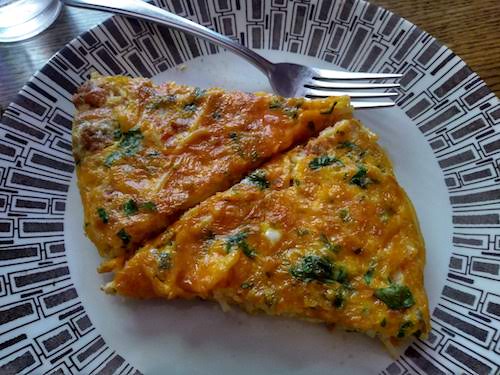
I made leftover spaghetti frittata for the first time at the end of March. This was when I kept scrolling news in hopes of good news, and there was none. I kept checking in on food writer @emikodavies under lockdown in Italy, and it was some solace to see her family’s daily life continuing, albeit in confinement. If they could keep going, so could I, was my reasoning. The recipe she posted in her feed also appealed to me for its frugalness. This was in my “reusing parchment paper” phase, when I was worried about food availability. It made a meal that was as comforting as it was delicious.
I do not think the pandemic is over. And I WOULD go into detail about our rituals, the ways we’re taking precautions, but I won’t, because reading such posts from other people makes me anxious. Suffice it to say, however, that we have not returned to business as usual. But we have also found ways, in this new reality, to reclaim joy and pleasure, and it’s not at all as incongruous as a lot of people might think.
I do not think the pandemic is over, but I really want to celebrate how far we’ve come since that dismal day in late March when I first poured eggs into my spaghetti. I think a fixation on US politics here in Canada has confused many people about the many ways their situation is different from our own. And there are, of course, a hundred other reasons to be lugubrious right now…but we’re still here, and now it’s summer, basil blooming in my garden, which I mixed into our frittata today.
There have been unfathomable losses, it’s true, but things are better now, infection rates here in Ontario continue to be low, community spread decreasingly a factor. The pandemic is not over, but do you not see still what a wonderful thing this is? That we are not without reasons to be hopeful after all?
I am going to make spaghetti frittata forever, I think. I am going to use spaghetti even as a means to frittata, in fact, and it’s going to remind me of these days, of all we’ve learned about community and connection, living with uncertainty and weathering hard times. Of what grows, and persists, and even blooms.
The pandemic is not over, but we have come such a long way.
April 12, 2018
The Soup My Children Eat

Having children is a challenge to any notion of living in the moment, not just because children rarely sit still, but also because a moment in the life of a child is as changing as a garden in May. And so the closest I’ve come to really being present is looking back on five minutes previous and saying, “Well, thank goodness that’s over, and isn’t it amazing to be here right now.” Which is basically what I’ve been saying for my children’s entire lives, the first six weeks of their existences notwithstanding.
Of course, it helps that I am an insufferable diviner of silver linings. I also know that it’s not always going to keep getting better and better, this experience of raising children. Life is complicated. Although I am so insistent when it comes to those silver linings that I might possibly end up deluding myself into thinking this is the case—I’m an unreliable narrator. But still, here we are, with my children on the cusp of being five and nine, and we’ve never had it so good. Sometimes we go out for dinner, and I don’t even need to be bring crayons. All those terrains that were unnavigable by stroller are now ours for the taking—I look forward to a summer of walks in ravines. And when we wet our pants, it’s a special occasion instead of a regular occurrence. We’re capable of having interesting conversations that 35% of the time don’t descend into an in-depth analysis of farts. We can all go to the same movie and enjoy it, and even Iris has been following along with our reading of A Wrinkle in Time. But what makes me happier than anything else is that finally everybody likes soup.
It has taken years to get here. I don’t know why. You’d think that soup would be child-friendly, as it doesn’t even require teeth to eat it, but my children were soup-intolerant from the get-go. And in some ways, I understood—small children like food to be straightforward and not touching, and soup was everything mixed up in a bowl. I would puree it, but they always claimed it tasted terrible. Chicken noodle they would tolerate, but only because they’d just pick out the noodles. And all of this was very hard on me, because soup is one of the things I love best in the world. Warm and comforting, full of nutritious goodness, handy for leftovers, and how it warms the house and steams everything up so you can draw hearts on the windows. I really love soup, and I never gave up serving it to my children in the hopes that one I’d finally succeed at making them love it too.
The tide finally turned about a year ago. I remember the night it happened—I served the soup thinking, “Will tonight be the night?” As I’d done numerous nights before, but this one did the trick. Everybody ate the soup. The blandest soup, it was true, but I was not going to quibble about details. Soup was soup and we were eating it together, and I kept serving it, gradually adding flavour. Originally it was sweet potato and I started using butternut squash instead, but not telling them. They kept eating it. I added a bit of curry—nobody complained. And now I serve it weekly, and everybody’s the teeniest bit sick of it, but they indulge me and also they don’t get a say because I’m the one cooking. We like to have our soup with a loaf of oatmeal quick bread and hummus and cheese on the side, as well as a drained can of chickpeas roasted in the oven with salt and olive oil as the bread is cooking.
The Soup My Children Eat (Adapted from here)
Ingredients:
2 tablespoons coconut oil
1 onion, chopped
4 garlic cloves, minced
1 teaspoon curry powder
1/2 teaspoon chilli powder
3/4 teaspoon salt
1 butternut squash, peeled and diced (or 4 sweet potatoes)
6 cups of chicken or vegetable stock
1 can of coconut milk
Instructions:
Melt olive oil in a stock pot. Add onion and garlic and let them soften, then stir in spices. Add diced squash, and then stock. Bring to boil and simmer for 20 minutes (or longer?) and then add coconut milk. Puree with an immersion blender.
November 30, 2017
Eating all the pies

I felt very liberated when I read in a cookbook about pies that one should use store-bought puff-pastry always, because attempting to make puff-pastry from scratch was just stupid. I don’t really know if the author of my pie book is an authority (according to wikipedia, she’s an interior designer and pies are just a sideline) but I’m not going to ask too many questions, because puff-pastry makes pies so easy. Savoury pies, I mean, as in for a meal. I still have pretty strong feelings about pastry from scratch for fruit or dessert pies. But puff-pastry means you could have a meat pie on the table as an easy weeknight supper. And we were all over that while we were reading The Piemakers, by Helen Cresswell, which our librarian recommended to us recently and we read-aloud with pure delight. A story that reminded me so much of The Borrowers in tone that I kept forgetting that the characters were not miniature—although the giant pie dish in which they float down the river didn’t make the scale any less confusing. It’s about a family of pie-makers—the daughter is called Gravella, named for Gravy—and it all goes wrong when they get the opportunity to bake a pie for the actual king. (Too much pepper, cough cough.) But then they get another chance to redeem their pie-making reputation, and everyone in the village pitches in, and (spoilers!) the result is a pie-making triumph. We loved it. But it made us hungry. And let me tell you the other best thing about store-bought puff pastry? That it’s sold in packages of two.
October 13, 2016
On Blogs and Food Blogs: a Conversation with Emily Wight
 Emily Wight is author of the cookbook, Well Fed Flat Broke, which is the cookbook that taught me what people are talking about when they talk about reading cookbooks for pleasure. She is also the longtime writer behind the blog of the same name, and I really admire her work and her perspective on blogging.
Emily Wight is author of the cookbook, Well Fed Flat Broke, which is the cookbook that taught me what people are talking about when they talk about reading cookbooks for pleasure. She is also the longtime writer behind the blog of the same name, and I really admire her work and her perspective on blogging.
I’d always wondered if my own philosophy of blogging (that blogging should be easy, fit nicely into your life, never be a chore…) was relevant to food blogging. Emily was kind enough to answer my questions about food blogging, and blogging in general, and what it means to be an old school blogger still at it in 2016.
*****
Dear Emily,
I really admire your blog, your book, and all you do, and it occurs to me that you might the perfect person for something I’ve been wanting to do for a while. I teach a blogging course at UofT and think about blogging a lot, have all kinds of theories about blogs as a radical space, for women in particular. and how blogs have certainly been hijacked by commercial interest. My favourite thing about blogs is there inherent messiness, how they’re works in progress, an exercise in making it up as you go along…
But I also know that this doesn’t quite work for food blogs. A lot of work is required for a food blogger. Whereas I see a blog as a great place to practice the art of imperfection, a food blogger has to get it right or else she’ll be messing up her readers’ dinners. There is also the nature of sponsorship…
Anyway, I would be really interested in reconciling my own ideas about blogging with the realities of food blogging and expanding my understanding of blogging in general. Would you be willing to engage in a back and forth email conversation over a few days to get some of these ideas flowing?
**
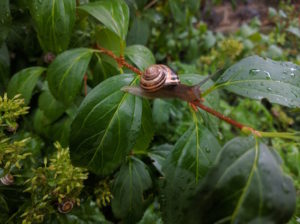 EMILY
EMILY
I’d be happy to help! But also food blogs can be messy and alive, it’s just harder to find them now. I really like Poor Man’s Feast and The Yellow House, but to be honest I’ve really moved away from reading a lot of food bloggers. By the time fall comes, I never want to see another recipe for squash soup as long as I live. I think the “why” behind food blogging has shifted from when I started one million years ago in 2007/08, certainly.
**
KERRY
Okay, so here is my first question. My whole deal is that blogging should be easy, it shouldn’t be a chore. If blogging is hard and taking up too much time, I preach, then you’re doing it wrong. But with food blogging—I suspect and as I’ve been told—there is recipe testing required, you can’t do typos (or else you can end up with a tablespoon of salt when it should have been a teaspoon). It’s a whole different game. Not to mention staging required for photographs… Has this been your experience? Is food blogging inherently hard? Is there a way to fit food blogging sustainably and easily into one’s life?
**
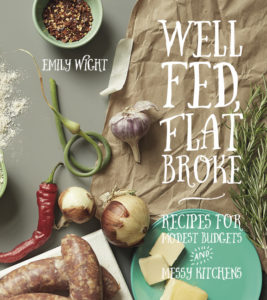 EMILY
EMILY
I don’t think food blogging is inherently hard—I have a much easier time of it than something like, say, fashion blogging, because I understand food but clothes remain a mystery to me. In most food blogging, food is the creative outlet—it’s a kind of art of its own, and so blogging about food is really just communicating a different form of expression, if that makes sense?
I think that people get satisfaction from different parts of it. I’m not a great photographer, so for me the staging and photographing is an afterthought, because no amount of effort in that regard is going to make my crappy iPhone photos significantly better; I think I’m a decent writer though, so I hope to coast on the quality of the writing and the recipes. For other people who are perhaps better photographers, maybe the writing feels hard.
In terms of accuracy and recipe development, that is a unique challenge but again I’d liken it to its own art form. Like, why would anyone do this if they weren’t either creating or archiving something? For me food blogging made sense—my education is in creative writing, but I am most excited about food, and we have to eat anyway. Food blogging became a way to write every day, or at least fairly often at a time when I might not have known what else to write about.
“Food blogging became a way to write every day, or at least fairly often at a time when I might not have known what else to write about.”
The challenge of sustainability now, I find, has less to do with the form and more to do with my own motivation. There’s a lot of “content” out there. I recognize that this is my own problem—food blogging is very different in 2016 than it was in 2008, and there are so many new voices that it can be hard to wade through and find your people. I won’t read on if I feel like a blogger is writing sponsored content, which is perhaps unfair, but again there is just so much out there now that I get to choose not to be marketed to if I don’t want that. At this stage, I am really looking for writers who make me look at food differently, or who use food as a vehicle for a larger story, whether there’s a recipe at the end or not.
**
 KERRY
KERRY
So interesting. I am also really invested in the idea of blogging as a process, and a never-ending one too. An opportunity to learn and grow. That is why I started blogging about books back in 2007ish. Which is definitely at odds with the way that most bloggers these days are urged to position themselves as experts and gurus. I feel like we don’t get to see any of the process anymore, that the process is regarded as mess, something to be swept into the corners.
Did you have any food blogger “credentials” when you started blogging back in the day? Were they even necessary? You talk about motivation for food blogging—do you think people blogging in 2016 are blogging for blogging’s sake, or are they blogging with the intention of a book deal or some other professional opportunity? And I want to know also—what motivates you to keep blogging after all this time?
**
 EMILY
EMILY
It’s totally a process! That’s why I don’t delete all my terrible, very bad posts with their clunky writing and hideous photos, because I like the idea that you can follow someone back through their process of growth. I remember when I first discovered The Bloggess in maybe 2009, and she was so funny and wonderful, and I had an evening alone (and no children), so I went all the way back through her archives and marveled at how her voice had strengthened and changed as she worked at it. There’s value in the process, and if nothing else it’s reassuring to be able to go back and see how you’ve evolved.
“I don’t delete all my terrible, very bad posts with their clunky writing and hideous photos, because I like the idea that you can follow someone back through their process of growth.”
I think the difference between then and now is really in how we’ve come to view online writing—the idea of “content” creates this sort of urgency to post regularly, to demonstrate value and expertise and keep people coming back. There has always been talk of “building an audience,” but prior to maybe 2011 the message was “make something valuable and people will come.” I don’t think that’s changed, but social media has really altered how that happens—now you don’t just have to make good blog posts, you also have to market them, and you—that was always kind of the case, but there’s so much more “content” out there now, that you have to put in a lot of effort—on a greater number of platforms—to stand out. If you want to do it well now, you have to think of yourself as a “brand” which honestly just feels so ridiculous. I get it, but I don’t want to do it.
“There has always been talk of ‘building an audience,’ but prior to maybe 2011 the message was ‘make something valuable and people will come.’ I don’t think that’s changed, but social media has really altered how that happens.”
Which is not to say that people who are doing it are doing blogging wrong, it’s just that the culture has changed. It does seem like people spring up fully formed overnight, with these beautiful sites and strong voices, but I wonder if part of that is that these are people who are approaching it with more online experience. When I started, I had had a Facebook account for maybe a year and that’s about it; I think now, for a lot of people, the social and visual aspects of blogging come pretty naturally. The technology is better—everyone has an iPhone now and iPhones take pretty good pictures. Getting to where you can be seen as an expert in whatever you’re doing is not such an investment as it used to be. “Anyone can do it” has turned into “anyone can do it well.”
 I didn’t really have much in the way of credentials when I started, short of a writing degree. But is a writing degree any less a credential than professional cooking experience, if the blog’s audience is the home cook? The people who did really well early on had really strong perspectives—people like David Lebovitz, or Luisa Weiss, or Pim Techamuanvivit (who has since quit blogging). They really created the model for what you see a lot of people doing now, and I think created a sense of what you can do if you do well online.
I didn’t really have much in the way of credentials when I started, short of a writing degree. But is a writing degree any less a credential than professional cooking experience, if the blog’s audience is the home cook? The people who did really well early on had really strong perspectives—people like David Lebovitz, or Luisa Weiss, or Pim Techamuanvivit (who has since quit blogging). They really created the model for what you see a lot of people doing now, and I think created a sense of what you can do if you do well online.
Do people blog just to blog, or do they want something else, like a book deal? I don’t know. I think people sit down and open a WordPress account for the same reason they ever did—a desire to connect, to write, or just to find their people online. But I think there is more of a sense that if this goes well, there are other opportunities in it. People take bloggers more seriously now than they did even a few years ago. You certainly see a lot of blogger cookbooks now, and they are often quite well done (and do very well).
“I think people sit down and open a WordPress account for the same reason they ever did. But I think there is more of a sense that if this goes well, there are other opportunities in it.”
As for me and why I still do it? Well, I certainly do it a lot less than I used to, because now I feel like I only want to write when I have something to say, or a recipe that’s really worth sharing, or to gauge whether what I’m working on is something people want to see more of. With other social media, like Instagram or Facebook, I still feel very connected to my community, so I spend a lot of time on there and other platforms. I treat my site as more of a portfolio—I don’t get paid to write on my blog (I don’t do ads or sponsored posts), but it generates other opportunities. It also allows me to work out my point-of-view a bit, and to figure out what I want to do. I would not have had the opportunity to write the book without the blog; now that I’ve written the book though, the blog is still very important in that it’s a place to dabble and experiment with what I want to do next. It’s a very public way of working shit out for myself. I also get the benefit of feedback—people will make the recipes or comment on the writing, so I know pretty quickly what’s working and what’s not. It’s a hard thing to let go of, especially if you came up in writing workshops and are used to a more collaborative approach to the creative process.
This ended up being a lot of words! In short, I think that blogs are valuable and the evolution and messiness is valuable and we’re in a time of transition, because at this point blogs aren’t going away and also there are always more blogs. But like anything produced en masse, there’s good, meaningful stuff in there and I want to see it, especially if it’s a bit unrefined.
**
 KERRY
KERRY
You are my blogging soul sister! That space to grow and evolve is so essential to successful blogging, I think (and I think a lot of bloggers who head into the gig thinking strategy and imagined outcomes are going to trip up on that). I am curious about your ideas about actually reading blogs. In my course, whenever I ask students what blogs they read, they usually shrug their shoulders and admit, “none!” Which is not to say that nobody reads blogs. I think that lots of people read blogs, but we come to them more laterally. I read food blogs all the time, but usually find them by googling whatever happens to be in my fridge and seeing what recipes result. I used to use a blog reader back in the day, but then Google ended it, and my blog reading was kind of rudderless after that—and I missed blogs. So I actively sought out a blog reader (I use protopage.com) which made reading blogs more of a regular habit. Kind of anachronistic, but I like it old school. I have a small but loyal group of readers who seem to feel just the same (and this is not JUST my mom). Anyway, I am interested in your thoughts on reading blogs and also finding readers. As you said, social media is a huge part of this.
Also, regarding the messiness: do you think it’s just too terrifying for some people to show their mess in public? Is that’s what’s driving the push toward tidy blogs? And by tidy, I mean antibacterial robot blogs? Is the blogger who’s willing to show her process taking risks that might be unwise?
**
 EMILY
EMILY
Ha! I’m glad we’re on the same page, as I often feel like I am a cranky old man about everything and no one understands 😉
Google Reader did kill blog-reading for me, in a lot of ways—remember when you could follow, like, 50 blogs? 100 blogs?! Haha, no. I don’t read a huge number of bloggers, but I have kept up with the ones who tell good stories, or who make me laugh. I love Afroculinaria, and Eating From the Ground Up, and The Pizzle, food-related blogs that offer more than just content. The thing about “content” is it’s stuff meant to fill space. How much of what we’re putting out there is valuable? How much can any one person care about? I know content when I see it, and there’s a real difference between reading something someone put thought and time into and some junk they threw up just to have a post on Tuesdays as per usual, you know? And so, I am reading fewer and fewer blogs. But the ones I am reading, I’m really invested in. Like, I would be genuinely sad if they went away. But you’re right, I don’t think people “read” blogs in the same way that they used to—I agree, I definitely come to blogs more laterally now, and I don’t often click “follow” on the blog when I find someone I like—I find them on Instagram, or on Twitter or Facebook.
I also get to say all that as someone who has been around long enough to not really have to hustle for readers. Do I need more readers? I am sure in terms of marketing books more readers would be valuable, but I am not unhappy with how I am doing, and the amount of traffic moving through the site on a daily basis, even when I don’t post very often. I recognize that the landscape is different now, and I get to be someone with cobwebs and cat hair and it’s, like, my thing. Maybe it’s not that we’re not hustling, we’ve just earned the ability to not have to? Maybe those newbies with their neat presentations and good cameras and shiny websites look at people like us, who have been around a long ass time and don’t feel obligated to bother with Pinterest, with envy?
“Maybe it’s not that we’re not hustling, we’ve just earned the ability to not have to?”
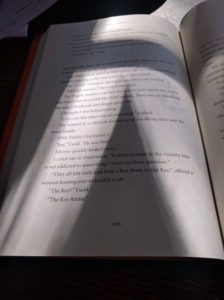 It might be scarier now to show your mess in public. Mess isn’t marketable, and I think because there are so many blogs out there now, you need to look like you know what you are doing in order to be taken seriously, or at least to be followed by people who don’t care about stuff like messiness and the creative process (which I think is most people). Another aspect of this is that a lot of these blogs are or want to be businesses—and businesses run quite a lot differently than creative projects. I want to say this in a way that doesn’t make me sound like an asshole (because I don’t mean anything offensive by it), but there’s a difference between writers and people who like to write; I think writers, or people who have always written (in the writers-as-artists sense), may value the mess and the show-of-process more than people who like to write but have other ambitions for their blogs. Writers aren’t penalized for having written shitty first drafts (or having evolved through a period of shitty-first-draftyness) because it’s expected, that’s what we do. But bloggers who want to turn blogging into something else, something beyond cookbooks or novels or whatever, maybe they approach it differently, and are more thoughtful about how they present themselves.
It might be scarier now to show your mess in public. Mess isn’t marketable, and I think because there are so many blogs out there now, you need to look like you know what you are doing in order to be taken seriously, or at least to be followed by people who don’t care about stuff like messiness and the creative process (which I think is most people). Another aspect of this is that a lot of these blogs are or want to be businesses—and businesses run quite a lot differently than creative projects. I want to say this in a way that doesn’t make me sound like an asshole (because I don’t mean anything offensive by it), but there’s a difference between writers and people who like to write; I think writers, or people who have always written (in the writers-as-artists sense), may value the mess and the show-of-process more than people who like to write but have other ambitions for their blogs. Writers aren’t penalized for having written shitty first drafts (or having evolved through a period of shitty-first-draftyness) because it’s expected, that’s what we do. But bloggers who want to turn blogging into something else, something beyond cookbooks or novels or whatever, maybe they approach it differently, and are more thoughtful about how they present themselves.
Did you see Luvvie Ajayi’s post on having been blogging ten years? She talks a bit about her process, and she had a few points I liked. This one, on evolution: “This blog has evolved with me. And my changed beliefs, my maturity and my growth as a person can be charted through the last ten years. How you start is not going to be how you continue and finish and that is okay. You are human.”
This resonated, because I think this is what’s been so great about blogging. I started out when I was 25 and still really immature in terms of my voice and my world view, and I am happy I can go back even three or four years and see that I have made progress, and that I am maybe a better version of who I was when I started. And maybe that kind of thing won’t matter to most people, but there’s a vulnerability in not being your tidiest, best-branded self and I think that resonates with the kind of readers who will stick with your writing long-term.
Follow Emily Wight on Twitter and Instagram, and stop by to read her blog.
February 13, 2016
Happy Valentines Day
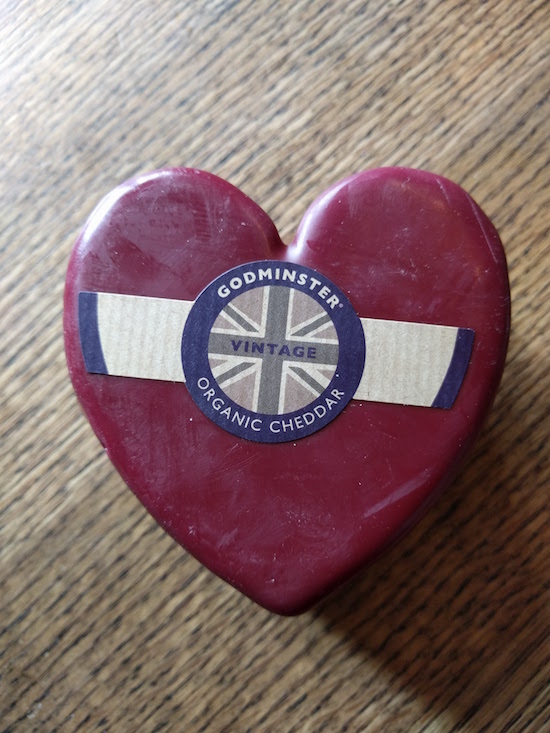
Everything’s been a special occasion around here lately, what with Pancake Tuesday and the fact that we had afternoon tea for dinner the day after that. And now it’s a long weekend, four days of it if you count Harriet’s PA Day, and we’re stretching out our Valentines Day celebrating and marking it with cheese. (Long weekend adventures have been extensively instagrammed.) It’s freezing cold outside but everything around here is wonderful and cozy, which feels nice after our terrible boring Christmas vacation rife with sickness. I just finished reading my second novel by Tana French (you MUST read Tana French) and now for sentimental reasons, am about to embark upon a reread of The Republic of Love.
October 21, 2014
All the Squash
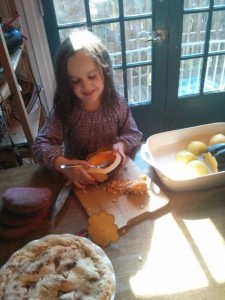 Oh, so little sleep (Iris has a cold and is getting molars) and three part time jobs means that my mind is scattered this week, but I want to take a pause and write about squash. It’s partly the time of year, and also because brand new cookbook The Everyday Squash Cook entered our lives, but no matter the reason, we are squash obsessed. Our Thanksgiving was made rich with acorn squash pie (see Harriet cleaning out the seeds, which we later roasted with the recipe from The Everyday Squash Cook) whose recipe I invented by mistake, but it turned out gloriously—I roasted the squash with the spices and butter in it, and then baked it all in an oatmeal crust. We also had this delicious Roasted Apple and Acorn Squash Soup and it was as easy to make as it was wonderful.
Oh, so little sleep (Iris has a cold and is getting molars) and three part time jobs means that my mind is scattered this week, but I want to take a pause and write about squash. It’s partly the time of year, and also because brand new cookbook The Everyday Squash Cook entered our lives, but no matter the reason, we are squash obsessed. Our Thanksgiving was made rich with acorn squash pie (see Harriet cleaning out the seeds, which we later roasted with the recipe from The Everyday Squash Cook) whose recipe I invented by mistake, but it turned out gloriously—I roasted the squash with the spices and butter in it, and then baked it all in an oatmeal crust. We also had this delicious Roasted Apple and Acorn Squash Soup and it was as easy to make as it was wonderful.
 The squash that continues to challenge me is spaghetti—I don’t buy those recipes pretending the strands are pasta, and neither do my children. It’s okay roasted, but there is so much and the kids won’t eat it, and I don’t like it that much. We receive them often in our organics delivery, however, and I think we may have finally found the solution—a spaghetti squash soup recipe from The Everyday Squash Cookbook, featuring coconut milk for maximum deliciousness and the strands do indeed pass as noodles in a soup. So good.
The squash that continues to challenge me is spaghetti—I don’t buy those recipes pretending the strands are pasta, and neither do my children. It’s okay roasted, but there is so much and the kids won’t eat it, and I don’t like it that much. We receive them often in our organics delivery, however, and I think we may have finally found the solution—a spaghetti squash soup recipe from The Everyday Squash Cookbook, featuring coconut milk for maximum deliciousness and the strands do indeed pass as noodles in a soup. So good.
A mysterious squash turned up on our delivery last week. The Everyday Squash Cookbook has a squash identifier, but I couldn’t find our mystery squash. So I turned to this rather nifty Winter Squash Visual Guide to discover it was a Delicata Squash. I roasted it according to this recipe to learn another thing—that Delicata Squash is the most delicious squash ever.
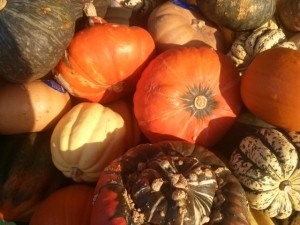 More squash? We made Butternut Bacon on the weekend from TESC (you can see the recipe here) and it blew our minds. Easy peasy and it cooks in 20 seconds. And then we were left with a whole bunch of butternut squash, so I used a vegetable peeler to thinly slice it, and made a “pizza” from those slices, inspired by a recipe in Tessa Kiros’ Apples for Jam: mix slices in a bowl with olive oil and flour until slices are coated, then turn onto a pie plate and bake for about an hour. Top with tomato paste, oregano, and mozzarella cheese and bake for 10 more minutes. It’s so good, though Harriet wouldn’t eat it, but that’s not much of an indicator of anything.
More squash? We made Butternut Bacon on the weekend from TESC (you can see the recipe here) and it blew our minds. Easy peasy and it cooks in 20 seconds. And then we were left with a whole bunch of butternut squash, so I used a vegetable peeler to thinly slice it, and made a “pizza” from those slices, inspired by a recipe in Tessa Kiros’ Apples for Jam: mix slices in a bowl with olive oil and flour until slices are coated, then turn onto a pie plate and bake for about an hour. Top with tomato paste, oregano, and mozzarella cheese and bake for 10 more minutes. It’s so good, though Harriet wouldn’t eat it, but that’s not much of an indicator of anything.
One of my favourite squash recipes (which Harriet does eat) is this ridiculously easy risotto that requires no stirring because it bakes in the oven. I usually use butternut squash and it’s very good.
Tonight we’re looking forward to trying the Squash/Sausage/Rigatoni recipe from TESC. I am quite sure it will prove delicious. Check out this recipe for Butternut Brownies, and also this article on squash as one of “Canada’s heritage foods.”
March 27, 2013
The Stop by Nick Saul and Andrea Curtis
 Oh, there is nothing quite like the The Stop’s Farmers’ Market. To get there, we have to trudge up the hill above Davenport Road, which is no small feat pushing a stroller, but the journey is worth it. In the winter, to arrive inside the big hall at Wychwood Barns, full to bursting with people touring around the tables heaped with fresh produce, delicious breads and cheeses, and other wonderful things. In the summer, the market spills outside into the grounds surrounding the Barns, and you’ve got to set a budget or else you’ll go mad–cherries, pickles on sticks, cinnamon buns, sushi, honey, cookies. We don’t want to snack too much because we’re planning on having our lunch at the Market Cafe, and then after lunch, the kids play on the splash pad while we wait, hoping the artisanal cheese doesn’t melt in the bottom of the stroller. Such concerns such a luxury and these Saturday mornings a highlight of family life in the city.
Oh, there is nothing quite like the The Stop’s Farmers’ Market. To get there, we have to trudge up the hill above Davenport Road, which is no small feat pushing a stroller, but the journey is worth it. In the winter, to arrive inside the big hall at Wychwood Barns, full to bursting with people touring around the tables heaped with fresh produce, delicious breads and cheeses, and other wonderful things. In the summer, the market spills outside into the grounds surrounding the Barns, and you’ve got to set a budget or else you’ll go mad–cherries, pickles on sticks, cinnamon buns, sushi, honey, cookies. We don’t want to snack too much because we’re planning on having our lunch at the Market Cafe, and then after lunch, the kids play on the splash pad while we wait, hoping the artisanal cheese doesn’t melt in the bottom of the stroller. Such concerns such a luxury and these Saturday mornings a highlight of family life in the city.
That’s not the half of it though, as demonstrated by the stories told in the new book The Stop: How the Fight for Good Food Transformed a Community and Inspired a Movement by Nick Saul and Andrea Curtis. We thought we knew what The Stop was all about–I bought their cookbook a few years ago, and used it so thoroughly that it no longer has bindings (and I continue to use it still- oh, the fish tacos, the beef stew, that strawberry bread!!). We visit the market a few times a year when we’re hungry and in need of a trek. And this Christmas, we divided our annual food-bank donation in two and gave half the money to The Stop instead. But for all our enthusiasm, it turns out we didn’t know The Stop at all.
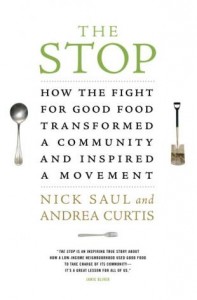 It turns out that the hub of The Stop is not the Green Barn, where the farmers’ market takes place each week, where Jamie Oliver paid a visit not too long ago. The real heart of The Stop, instead, lies a few kilometres west down Davenport Road at their main office, which was a small food bank when Nick Saul became executive director in 1998. It didn’t take long for Saul in this role to become disillusioned with the food bank system, which, he tells us, is a relatively recent invention. Food banks came about in the 1980s as a temporary solution to community hunger, but they stayed around as government programs for dealing with these problems were being reduced at the very same time. And now it seems as though we’ve always had them, food banks, systems we support by dumping store-brand Kraft Dinner in grocery store bins every once in a while before heading home to feast on artisanal cheese and organic kale.
It turns out that the hub of The Stop is not the Green Barn, where the farmers’ market takes place each week, where Jamie Oliver paid a visit not too long ago. The real heart of The Stop, instead, lies a few kilometres west down Davenport Road at their main office, which was a small food bank when Nick Saul became executive director in 1998. It didn’t take long for Saul in this role to become disillusioned with the food bank system, which, he tells us, is a relatively recent invention. Food banks came about in the 1980s as a temporary solution to community hunger, but they stayed around as government programs for dealing with these problems were being reduced at the very same time. And now it seems as though we’ve always had them, food banks, systems we support by dumping store-brand Kraft Dinner in grocery store bins every once in a while before heading home to feast on artisanal cheese and organic kale.
The Stop is written by Saul and his wife, award-winning writer Andrea Curtis, but told in Saul’s voice as he outlines his decade and a half with the organization. The problems with the food bank, he realized quickly, were manifold: it was a stop-gap measure; users picked up their hampers and left feeling diminished; the contents of the hampers weren’t anything that anyone would choose to eat, and did nothing to contribute to a healthy diet. There were other things going on at The Stop though that were having a more positive impact, such as their Healthy Beginnings Program, which taught food and nutrition skills to pregnant low-income women. Other initiatives came about–a community garden, cooking classes, drop-in meals. Around all these, a real sense of community began to form. Users came to The Stop and began to find it empowering, to find places where they could contribute to their communities and get involved.
Change is hard though, and Saul outlines how difficult it was to shift the centre’s focus away from the traditional food bank’s. First, because The Stop’s volunteers felt good about what they were doing and didn’t appreciate their efforts being criticized. The general consensus was that anyone using a foodbank hamper didn’t have the right to turn their nose up at anything, wilted lettuce, fetid peppers, and all. But Saul was convinced there had be a better way, and slowly, step-by-step, his organization began to blaze that trail. The community garden, he admits, is never going to feed the world, and there are many people who use The Stop whose problems are so complex that those problems are never going to be fully resolved, but many lives have been changed by the place (including those of the babies in their Healthy Beginnings program, all of whom were born at a healthy birth weight last year) and a community has found its spirit.
With The Stop’s Green Barn, Saul writes, “we can have a role tapping into the largely middle-class enthusiasm about food we’re seeing and connecting the dots between the poor and everyone else.” Because the poor, he explains, are largely excluded from the foodie revolution of the last few years. While I’m snacking on my organic kale chips, rising food costs are putting healthy food further and further out of reach of people who could benefit from it as much as I do. Saul checks Michael Pollan’s “vote with your fork” philosophy, and points out that for all the good of the movement, it leaves lower-income people as disenfranchised as they’ve ever been.
Nick Saul left The Stop in July 2012 to become president and CEO of Community Food Centres Canada, which aims to bring The Stop’s movement and innovations to communities across Canada, and after reading the book, I am confident in this new organization’s success and so excited by the work they’re doing. These aren’t political issues, Saul tells us, but instead these are issues of morality. The Stop is a fantastic story well told, compelling to read, and it will inspire readers to reconsider their relationships with both the food they eat and the people they live amidst.
June 6, 2012
To market, to market
 The market opened today, and it was a glorious bounty, perhaps due to our early spring. It was wonderful to see so many familiar faces, people we know from the neighbourhood and farmers we haven’t seen since last October who commented on how enormous Harriet has grown in the meantime. And it’s true– this time last year, I had to wear Harriet on my back to the market or else she’d escape, and then she’d scream whenever it was time to leave, and I think she got a bad reputation. Today, however, she stood at my side like an actual human being, and it was so exciting to see strawberries, beets, garlic scapes, cherry tomatoes, and kale, plus say hello to our favourite maple syrup and honey men. It is very nice to say hello to summer again, and also to see how far we’ve come.
The market opened today, and it was a glorious bounty, perhaps due to our early spring. It was wonderful to see so many familiar faces, people we know from the neighbourhood and farmers we haven’t seen since last October who commented on how enormous Harriet has grown in the meantime. And it’s true– this time last year, I had to wear Harriet on my back to the market or else she’d escape, and then she’d scream whenever it was time to leave, and I think she got a bad reputation. Today, however, she stood at my side like an actual human being, and it was so exciting to see strawberries, beets, garlic scapes, cherry tomatoes, and kale, plus say hello to our favourite maple syrup and honey men. It is very nice to say hello to summer again, and also to see how far we’ve come.
January 18, 2012
Porridge Mornings
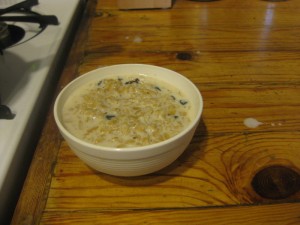 For the new year, I resolved to start hauling my sorry self out of bed just a wee bit earlier to cook a hot breakfast for our family to eat together. Partly because a hot breakfast is a good enticement to get out of bed at all, because it’s the best way to meet cold, dark winter mornings, and because Stuart would appreciate some early morning company. Three weeks in, we’re quite hooked on the habit, and have been changing up the porridge so it never gets tired. We’ve had steel-cut oats, regular rolled oatmeal and quinoa and barley porridge. My favourite, though, is brown rice porridge, inspired by Gwyneth Paltrow’s cookbook which I had out of the library over Christmas (which was pretty good, actually, even though her porridges are pretty bland. Her sweet potato ravoli was delicious though). Brown rice porridge remarkably simple to prepare when we cook up some rice in the rice cooker the night before. In the morning, toss the cooked brown rice in a saucepan, cover the rice with milk and warm it up, adding 2 tbspns of corn starch for thickening. For all our porridges, we’ve found that a couple of teaspoons of vanilla extract is the key to deliciousness, along with honey, cinnamon and nutmeg, raisins, diced apples or bananas. And whatever is leftover can be reheated the next morning.
For the new year, I resolved to start hauling my sorry self out of bed just a wee bit earlier to cook a hot breakfast for our family to eat together. Partly because a hot breakfast is a good enticement to get out of bed at all, because it’s the best way to meet cold, dark winter mornings, and because Stuart would appreciate some early morning company. Three weeks in, we’re quite hooked on the habit, and have been changing up the porridge so it never gets tired. We’ve had steel-cut oats, regular rolled oatmeal and quinoa and barley porridge. My favourite, though, is brown rice porridge, inspired by Gwyneth Paltrow’s cookbook which I had out of the library over Christmas (which was pretty good, actually, even though her porridges are pretty bland. Her sweet potato ravoli was delicious though). Brown rice porridge remarkably simple to prepare when we cook up some rice in the rice cooker the night before. In the morning, toss the cooked brown rice in a saucepan, cover the rice with milk and warm it up, adding 2 tbspns of corn starch for thickening. For all our porridges, we’ve found that a couple of teaspoons of vanilla extract is the key to deliciousness, along with honey, cinnamon and nutmeg, raisins, diced apples or bananas. And whatever is leftover can be reheated the next morning.
Easiest resolution ever.





